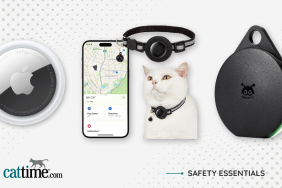
July is ‘National Lost Pet Prevention Month’ and serves as a vital reminder to make sure people take the proper steps so they don’t lose their pets.
Losing your beloved kitty cat can be one of the most devastating events of your life. Your cat is a member of your family after all, so losing them can feel like your child has gone missing.
While you may think that your cat will never get lost, there’s always the possibility something could happen. Make sure you prepare and take the necessary steps to prevent your cat from getting lost in the first place.
In honor of National Lost Pet Prevention Month, here are ten important tips to make sure you won’t ever lose your beloved cat.
1. Microchip Your Cat
Microchips have significantly helped reduce the amount of lost pets that end up in shelters and never find their way home. Thanks to this technology, shelters and animal rescues can quickly identify your cat’s name, your own contact information, and your vet’s information, and they can return your cat to you.
If your lost cat shows up at a shelter or veterinarian’s office, they can immediately scan them for the rice-sized microchip placed directly under the skin. It’s completely painless for cats to get, and they’ll go their entire lives not even knowing it’s there.
One quick injection can save you the hassle of having to worry that your cat has no identification. Legally, this can also help if someone steals your cat, as you can prove you are their rightful pet parent.
2. Have Documentation Ready

If something were to happen to your cat, you’d want to be as prepared as possible. This is why it’s vital you have all of your cat’s official documents organized and easy to locate.
The fastest way to reunite with your lost kitty is to have all of their information ready. That way you can provide proof of ownership to shelters, vets, and animal rescues instantly.
You should have a recent photo of your cat so you can put up “lost” flyers with what they look like at the moment, along with documents like vaccine records, your vet’s information, shelter information, and more.
Also have the phone numbers of local shelters or animal rescues on hand so you’d know immediately who to contact if something were to happen.
3. Find The Right Cat Carrier
Traveling with your cat brings a high risk of losing your pet. Unlike dogs, cats are homebody creatures and don’t often tag along for casual travel.
When you do have to travel with a cat, they’re more likely to feel scared and disoriented, thus leading to more of a chance that they could escape and get lost or killed.
Cat carriers are extremely important in preventing your cat from getting lost. They not only keep your cat safe while traveling in a car, but they prevent cats from jumping out and running away when you open your door to get out.
Also, cats like to be in enclosed, tight spaces when they feel uncomfortable, so cat carriers provide them with relief while keeping them safe.
There are many carriers to choose from depending on the age of your cat, their size, and the distance of travel, so make sure you choose the best one for both you and your cat.
4. Have A Leash And Harness
While owning a leash and harness may seem obvious to a dog person, it’s important to remember that cat parents should also have a leash and harness on hand for certain situations.
When you travel with your cat in a carrier, you can attach their leash and harness to them as a precaution. This way, when you remove your cat from their carrier, you can hold onto their leash to make sure they won’t bolt away.
Also, some people can actually take their cats for walks or have some outside time in their backyards using a leash and harness. This way, your cat can explore the outdoors while still staying safely at your side.
5. Secure Your Yard And Home
For indoor cats, it’s especially important that your home stays secure. Indoor cats who don’t usually go outdoors can easily become lost, as they’re unfamiliar with the new environment.
You may want to place gates in front of the doors you use to leave the house to prevent your cat from accidentally escaping. Additionally, if you leave windows open, make sure the window screens are secure and have no rips or tears that your cat can escape through.
If you want your indoor cats to have time outside, you can buy a fun play pen, catio, or tent enclosure that will allow your cats to experience the outdoors while staying safe.
If you want your cats to be able to go in your yard without roaming the neighborhood, first make sure the fencing around your house is completely secure. Cats are very flexible creatures who can squeeze through pretty much anything, so any lose panels or holes will be a problem.
Also, cats have a very easy time jumping, no matter the height of your fence. Lining the top of your fence with chicken wire may help prevent them from getting out.
6. Get A Collar With A Cat Tag

Every cat should have a collar with an identification tag, even indoor cats. There’s always the possibility your indoor cat could accidentally escape the house, so you’ll want them to have a collar for easy identification in an emergency.
Also, collars help prevent people from misidentifying your cat as a stray. It can be easy for a stranger to believe a cat without a collar has no human family. Collars make it clear that your cat is yours and has a home.
Cat tags not only have your cat’s name, but also vital information like your phone number and possibly your address. You can get custom cat tags online or make them at any local pet store.
To be extra safe, you can also write your phone number on the inside of the collar with a permanent marker. There are a variety of collars, so make sure you find the one that best suits you and your cat.
7. Spay Or Neuter
Spaying and neutering cats not only prevents overpopulation, but it also significantly reduces the chances of them getting lost.
Male cats who aren’t neutered have a high sexual drive, and in order for that drive to be met, they want to find female cats. Non-neutered cats are more likely to try and leave the house and go wandering off to find nearby female cats to mate with.
If you have an indoor cat, this can be especially problematic because they may continually try to escape from your house, which not only leads to getting lost, but also the possibility of death by cars.
Also, female cats who aren’t spayed will try to put their scent in as many places as possible for male cats to find, which increases the likelihood of them roaming the neighborhood. Neutering and spaying will relax your cats and make them better pets who actually want to stay near you.
8. Pay Attention

Not matter how many tips we can give you on how to keep your cat safe, the most important one will always be to pay attention. Paying attention may seem like a simple rule, but it can honestly be one of the most forgotten ones.
With things like work, kids, families, and more, it can be easy to forget to check in on your cat. However, remember that your cat is another member of your family. You wouldn’t forget to pay attention to your kids if they were playing outside, so you shouldn’t forget to pay attention to your cat either.
Always check where your cat is so you know their location and what they’re up to. You don’t have to check every second, but it’s good to have a sense of your cat’s whereabouts throughout the day so you can have peace of mind knowing that they are safe.
Also, if you let your cats outside, paying attention will help you make sure they don’t escape your yard.
9. Bring Outdoor Cats In When You Can’t Care For Them

For cat parents who let their cats go outside, it’s extremely important that you bring them in when you’re not home and when you go to bed.
For some cats it’s completely part of their normal routine to go outside, and that’s fine if that works for them. However, even though your cat might know their way around outside, if you’re not home and able to keep an eye on them, something could happen.
You’ll want to be around if you have to bring your cat in during an emergency. Also, small cats can be in danger due to coyotes, mountain lions, and hawks, so for this reason you definitely want to bring them in, especially at night.
10. Try Cat Training
You may think it’s impossible to train a cat, but think again. While cats are not the most cooperative creatures in comparison to dogs, it’s actually possible to teach your cat to come when called.
It may take patience and a lot of time, but it ‘s really important for your cat to become familiar with being called because it can help prevent your cat from getting lost and be helpful in an emergency.
If you know what motivates your cat, then you can train them. Food is a great way to get your cat to come. If they know the sound of a treat bag or the sound of you opening a can of wet food, you can associate that sound with their name.
By calling their name while making the sound of the food, the association will become stronger over time. Don’t give up because this tip can really come in handy.
Do you have any tips to prevent your cat from getting lost? Will you help spread the word for National Lost Pet Prevention Month? Let us know and leave a comment below!
Click the bold links in the article to shop for your cat and support our content!









